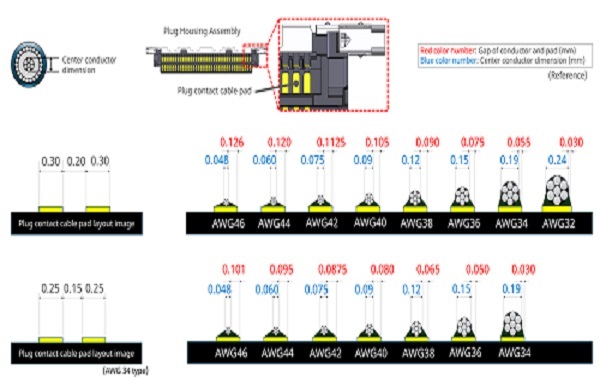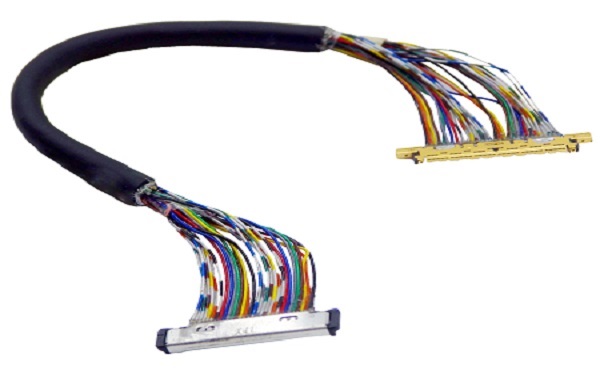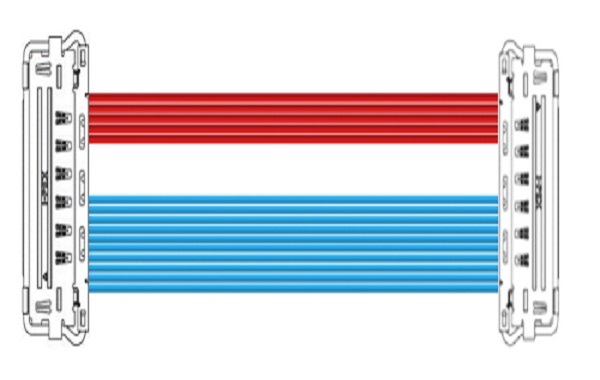Categorization:Harness Component
In high-speed signal transmission systems, the rational matching of connectors with cables is crucial to the overall performance. Especially in the assembly of micro-coaxial and twinaxial cable harnesses, the pin pitch of the connectors not only determines the outer diameter of the cables that can be matched but also directly affects the insertion loss in the signal path. With the continuous miniaturization of devices and the sustained increase in signal rates, how to balance signal integrity and transmission performance in structures with limited space has become a core issue that high-speed interconnect design engineers must face.
The relationship between pin spacing and cable size
Pin pitch refers to the distance between the center points of adjacent pins in a connector. Common micro-coaxial and dual-axis connector pin pitches are 0.5mm, 0.4mm, 0.3mm, and even 0.25mm. With the continuous miniaturization of electronic devices, the pitch tends to decrease, but the electrical performance challenges brought about by this are becoming increasingly prominent.
• Wide pin spacing (≥0.5mm)
The cable is adaptable to cables with larger core conductor diameters, featuring lower conductor resistance and dielectric loss. In high-frequency signal transmission, this cable exhibits lower insertion loss and better signal integrity, making it suitable for long-distance, high-speed applications such as high-speed mainboards, server backplanes, or interconnections of communication equipment.
• Smaller pitch (≤0.3mm)
Higher-density signal interface design can save PCB space, but due to size limitations, only finer conductor cables can be used, leading to increased resistance and dielectric loss. This type of solution is more suitable for short-distance transmission or space-saving devices, such as mobile terminals and portable electronic systems.
The relationship between insertion loss and conductor diameter
Insertion loss is an important indicator for measuring the degree of attenuation of signal energy in the transmission path, mainly originating from conductor loss, dielectric loss, and reflection loss. Among them, conductor loss is inversely proportional to the diameter of the cable's central conductor.
Thicker central conductor → lower resistance → smaller insertion loss
A finer central conductor → higher resistance → greater insertion loss
Therefore, in applications with high requirements for signal quality (such as PCIe Gen4/Gen5, USB4, Thunderbolt, and other high-speed differential signal channels), it is recommended to prioritize connector schemes with larger pin spacing and the ability to support thicker conductor cable, in order to reduce insertion loss, improve signal integrity, and ensure stable data transmission.
Section 3: Design Trade-offs and Application Recommendations
In high-speed interconnect design, the selection of pin spacing needs to achieve a balance between performance, structure, and cost.
Here are engineering recommendations for different application directions:
High-performance computing and server applications
Select connectors with a larger spacing (≥0.5mm) and low-loss micro coaxial cables to ensure stable long-distance, high-speed transmission.
2. Mobile terminals and embedded devices
In the case of space constraints, smaller spacing (≤0.3mm) is adopted, and losses are reduced through means such as shielding optimization and impedance matching.
3. Standardization and Mass Production Scenarios
Prioritize the combination of mature spacing and general cable to balance cost control and production consistency.
Pin spacing is a critical physical parameter in the design of micro-coaxial and dual-axis connectors, as it not only limits the outer diameter of the cable that can be matched, but also profoundly affects insertion loss and signal integrity. A wider spacing is conducive to the use of low-loss cables, suitable for high-speed, long-distance applications; while a narrower spacing is more suitable for compact space designs, but requires a balance between loss and density. By reasonably selecting the spacing and cable combination, engineers can achieve the best design solution in terms of performance, space, and reliability, ensuring that the system maintains excellent stability and consistency in the high-speed signal transmission environment.
I amSuzhou Huichengyuan Electronic TechnologyLong-term focus on the design and customization of high-speed cable harnesses and ultra-fine coaxial cable harnesses, committed to providing stable and reliable high-speed interconnection solutions. For more information or customized design, please contact:Manager Zhang 18913228573 (WeChat same number)。